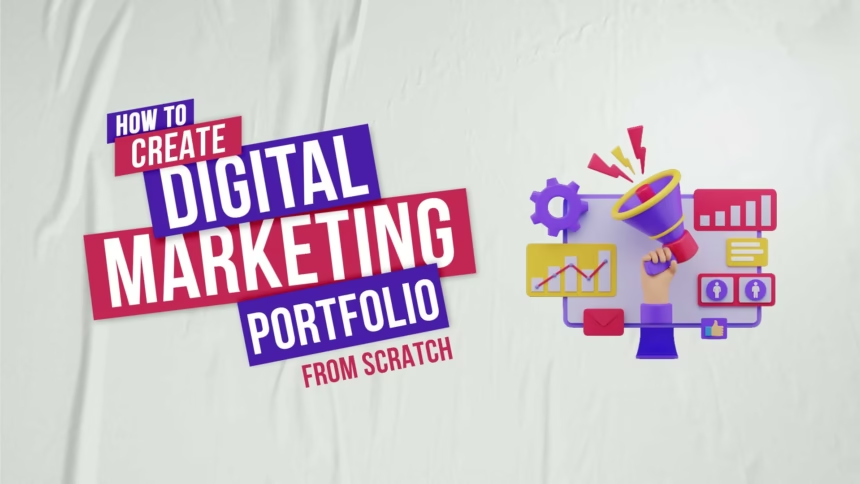If you’re trying to land digital marketing jobs or freelance clients in 2025, having a strong digital marketing portfolio is no longer optional. Whether you’re just starting or switching careers, this guide will help you build a simple but powerful portfolio that shows what you can do.
- Why a Digital Marketing Portfolio Matters in 2025
- Step 1: Choose Your Platform
- Step 2: Pick a Clear Niche or Focus
- Step 3: Add Real or Sample Projects
- Step 4: Break Down Your Work With Simple Explanations
- Step 5: Show Basic Metrics (If Possible)
- Step 6: Add an About You Section
- Step 7: Include Testimonials (Even From Friends or Classmates)
- Step 8: Keep It Updated
- Step 9: Make It Easy to Share
- Bonus Tips to Make Your Digital Marketing Portfolio Stand Out
- Conclusion
Why a Digital Marketing Portfolio Matters in 2025
Recruiters and business owners want proof. A CV tells, but a digital marketing portfolio shows. In 2025, with so many people applying for the same roles, your portfolio can make you stand out quickly.
It doesn’t matter if you’re self-taught, fresh from school, or changing careers. A digital marketing portfolio is the easiest way to prove you know how to do the job. It shows what you’ve worked on, your results, and what you can offer.
Step 1: Choose Your Platform
You don’t need to hire a web designer. You can build your digital marketing portfolio using free or low-cost platforms like:
- WordPress
- Wix
- Notion
- Google Sites
- Canva (for one-page portfolios)
Choose one that is easy for you to update. The most important thing is clarity and layout.
Step 2: Pick a Clear Niche or Focus
Are you into content marketing, email marketing, social media, paid ads, SEO, or analytics? Be clear. Your digital marketing portfolio should focus on your strengths.
Even if you know a bit of everything, pick one or two areas to highlight. Clients and employers love specialists.
Step 3: Add Real or Sample Projects
This is where most people get stuck. But even if you don’t have a job yet, you can still create sample work. Here are examples you can include in your digital marketing portfolio:
- A sample Instagram campaign for a local bakery
- A blog post written with SEO best practices
- A Google Ads sample plan
- A made-up email marketing funnel for an e-commerce brand
- A basic content calendar
- Website audit using a real site (with screenshots)
You can use tools like Canva, Google Docs, or even PowerPoint to show your work clearly.
Step 4: Break Down Your Work With Simple Explanations
Don’t just upload images or links. Explain what you did, why you did it, and what the results were (even if they’re made-up).
For example:
“I created this sample email series for a skincare brand targeting young adults. The goal was to increase repeat purchases. The emails are spaced three days apart and use simple calls to action.”
This kind of breakdown helps people understand your thinking process, not just the result.
Step 5: Show Basic Metrics (If Possible)
If you’ve worked on live projects or helped a friend’s business, share results like:
- Open rates
- Website traffic
- Engagement rate
- Click-through rate
- Follower growth
- Sales conversions
These help to give your digital marketing portfolio real-world credibility.
Also Read: 10 Genius Ways to Find Mentors in the Digital Space in 2025
Step 6: Add an About You Section
This part introduces who you are. Keep it short, clear, and honest. Include:
- Your name
- Your focus area (e.g., social media and email marketing)
- Why you love digital marketing
- What kind of clients or roles you’re looking for
Example:
“I’m Alex, a beginner digital marketer with a passion for storytelling and customer experience. I focus on email marketing and Instagram growth. I’m currently looking for freelance gigs or junior roles to grow my skills.”
Step 7: Include Testimonials (Even From Friends or Classmates)
If you’ve worked with anyone—classmates, group members, or early clients—ask them for a short quote. It helps build trust.
If you don’t have real testimonials, create a simple mock-up of imaginary reviews to show where you would place them.
Step 8: Keep It Updated
A digital marketing portfolio should be a living thing. Don’t build it and forget it. Update it regularly with new work or improved projects. You can even include your personal growth like certifications or course projects.
Step 9: Make It Easy to Share
When applying for jobs or gigs, always include your portfolio link. Put it in your email signature, your LinkedIn, and your bio on freelance platforms.
You can also create a one-page version of your digital marketing portfolio to attach as a PDF if needed.
Bonus Tips to Make Your Digital Marketing Portfolio Stand Out
- Add a short video intro: Even a 30-second clip introducing yourself adds a human touch.
- Use brand colors and fonts: Make your portfolio look neat and aligned with your personal brand.
- Create a separate section for tools: List all the tools you’ve used like Canva, Mailchimp, Buffer, Hootsuite, Meta Ads Manager, or Google Analytics.
- Use screenshots: Visual proof is powerful. Add clear images of your work.
Also Read: 10 Online Certifications in Nigeria That Actually Matter
Conclusion
Your digital marketing portfolio doesn’t need to be perfect. It just needs to be real, clear, and easy to understand. Use what you have now and build on it as you grow.
In 2025, a well-organised digital marketing portfolio will open more doors than any CV. Employers and clients want to see what you can do. Don’t wait until everything is perfect, start with what you have and show your potential.






